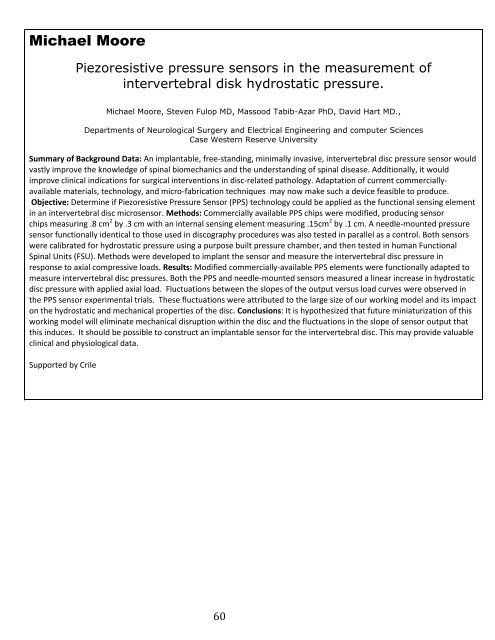student research day - Case Western Reserve University School of ...
student research day - Case Western Reserve University School of ...
student research day - Case Western Reserve University School of ...
Create successful ePaper yourself
Turn your PDF publications into a flip-book with our unique Google optimized e-Paper software.
Michael Moore<br />
Piezoresistive pressure sensors in the measurement <strong>of</strong><br />
intervertebral disk hydrostatic pressure.<br />
Michael Moore, Steven Fulop MD, Massood Tabib-Azar PhD, David Hart MD.,<br />
Departments <strong>of</strong> Neurological Surgery and Electrical Engineering and computer Sciences<br />
<strong>Case</strong> <strong>Western</strong> <strong>Reserve</strong> <strong>University</strong><br />
Summary <strong>of</strong> Background Data: An implantable, free-standing, minimally invasive, intervertebral disc pressure sensor would<br />
vastly improve the knowledge <strong>of</strong> spinal biomechanics and the understanding <strong>of</strong> spinal disease. Additionally, it would<br />
improve clinical indications for surgical interventions in disc-related pathology. Adaptation <strong>of</strong> current commerciallyavailable<br />
materials, technology, and micro-fabrication techniques may now make such a device feasible to produce.<br />
Objective: Determine if Piezoresistive Pressure Sensor (PPS) technology could be applied as the functional sensing element<br />
in an intervertebral disc microsensor. Methods: Commercially available PPS chips were modified, producing sensor<br />
chips measuring .8 cm 2 by .3 cm with an internal sensing element measuring .15cm 2 by .1 cm. A needle-mounted pressure<br />
sensor functionally identical to those used in discography procedures was also tested in parallel as a control. Both sensors<br />
were calibrated for hydrostatic pressure using a purpose built pressure chamber, and then tested in human Functional<br />
Spinal Units (FSU). Methods were developed to implant the sensor and measure the intervertebral disc pressure in<br />
response to axial compressive loads. Results: Modified commercially-available PPS elements were functionally adapted to<br />
measure intervertebral disc pressures. Both the PPS and needle-mounted sensors measured a linear increase in hydrostatic<br />
disc pressure with applied axial load. Fluctuations between the slopes <strong>of</strong> the output versus load curves were observed in<br />
the PPS sensor experimental trials. These fluctuations were attributed to the large size <strong>of</strong> our working model and its impact<br />
on the hydrostatic and mechanical properties <strong>of</strong> the disc. Conclusions: It is hypothesized that future miniaturization <strong>of</strong> this<br />
working model will eliminate mechanical disruption within the disc and the fluctuations in the slope <strong>of</strong> sensor output that<br />
this induces. It should be possible to construct an implantable sensor for the intervertebral disc. This may provide valuable<br />
clinical and physiological data.<br />
Supported by Crile<br />
60
















